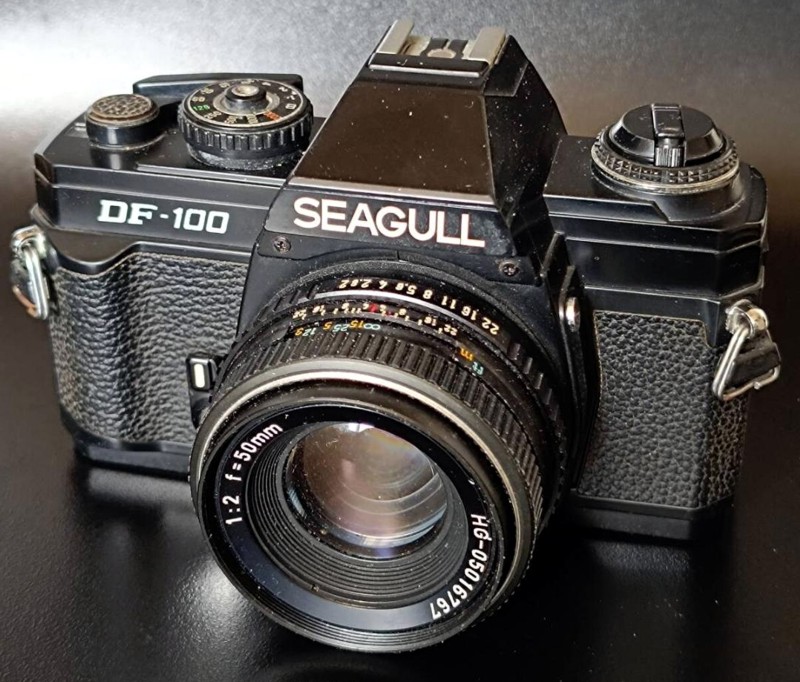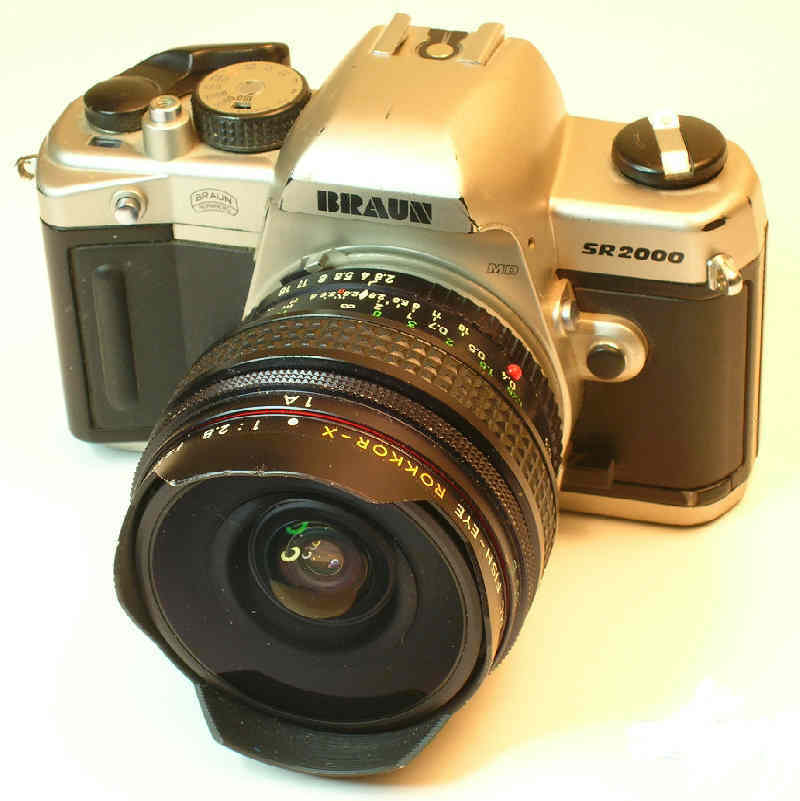

Let's start off with a Seagull DF-2000A matched up with a Tokina f2.8
80-200mm zoom lens.
Despite its name, it does NOT have a shutter speed of 1/2,000, but several of Seagull's cameras did. But it has has a couple of extra features. It has a quartz-controlled, electronic shutter -- so it needs batteries, and it also sports a double exposure lever right next to the film advance lever, and a "T" setting on the shutter speed dial, in addition to the typical "B" setting. It is a metered-manual exposure camera with a TTL meter, but no automatic exposure control. There are three, colored LEDs in the viewfinder that indicate a correct exposure or not. Otherwise, it is similar to the Minolta X-370n. The Tokina lens is a real performer. Not only does it have a f2.8 aperture, but it has multi-coated, APO glass and a one-touch zoom/focus design.
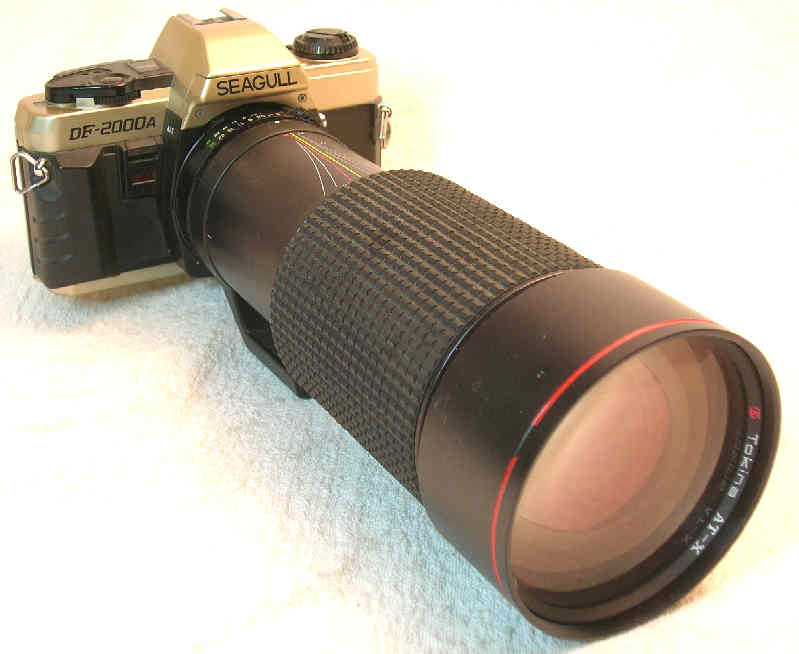
How about a Phenix DC500 riding on a Honeywell Lumetar 1250mm f10.5
lens? The lens is really just a stripped down Celestron C5
(Schmidt-Cassegrain-type, catadioptric mirror) telescope -- hiding in "sheep's
clothing".
Despite its size, it is very lightweight and powerful. Best of all, it is very sharp. It was originally designed, mainly, for astronomical use, but Honeywell had Celestron strip it down for, mainly, terrestrial use. It is not well known by photographers, so if you see one for sale it will probably go for a very low price -- when compared to the Celestron C5, which typically sells for $300-500 in used condition on EBAY. The aperture is fixed, so the depth-of-field is very narrow, but the image in the viewfinder is pretty bright for a lens of this focal length. Filters can be attached on the rear and a lens shade is not really necessary due to its Cat design -- which also happens to eliminate chromatic aberration. It attaches to a camera with a standard T-mount and has a non-rotating tripod socket on the bottom. It also lacks the spotting scope, on the side, which the C5 has, so the Honeywell version is a little lighter than the Celestron version. You can see a small strip of some of the original, orange paint that Celestron put on the lens around the circumference -- which is the normal color of a Celestron C5 -- here, almost completely covered up with a more attractive (in my opinion), black leatherette -- thanks to Honeywell.
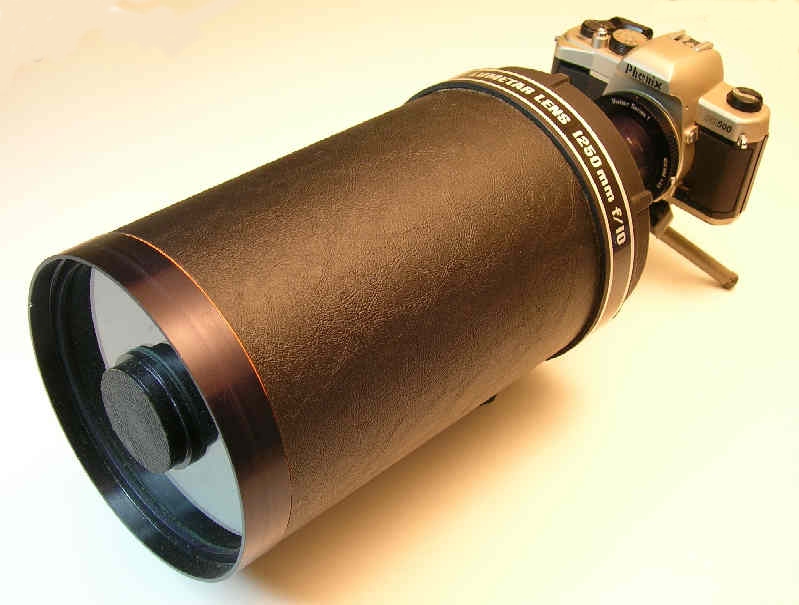
Here is a Tamron 35-105mm f2.8 Aspherical zoom lens on a Pearl River S-201. The Tamron uses an Adaptall II mount and is a parafocal, one-touch zoom -- with a FAST, constant aperture as you zoom!
You can't beat this Tamron for an all-in-one lens -- unless you are talking about the similar Tamron 28-105mm f2.8 zoom (which zooms a little wider), or the Minolta Rokkor 40-80mm f2.8 zoom (which focuses a little closer). Sure it's a little large and a little heavy, but it saves you from carrying a lot of lenses -- and the Aspheric elements assure top-notch results.
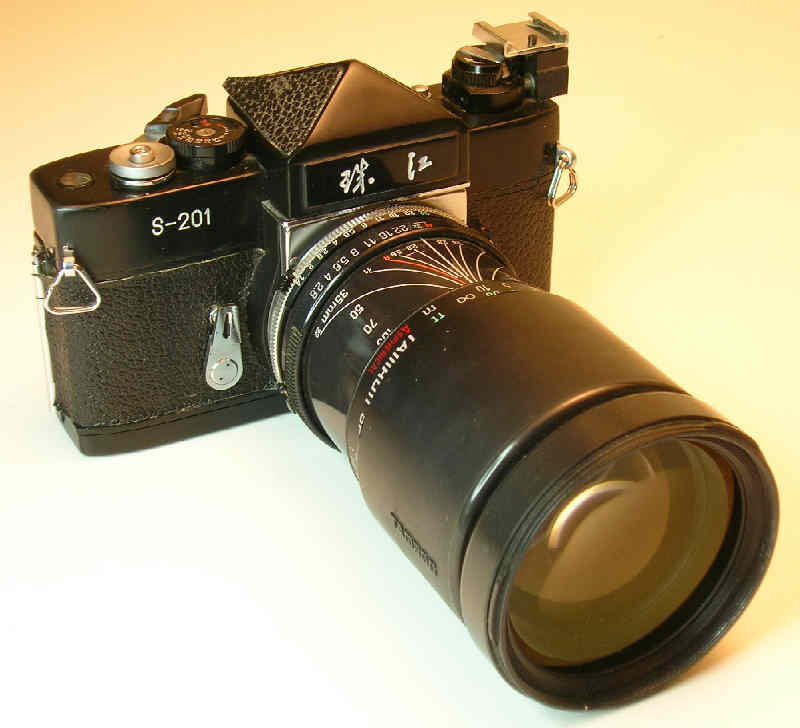
A Phenix DC10 with a compact Quantaray 28-70mm f3.5/4.5 zoom lens makes for a small, lightweight, do-just-about-anything package.
The camera is full-featured, and the lens is a one-touch zoom -- with a nice built-in depth-of-field scale!
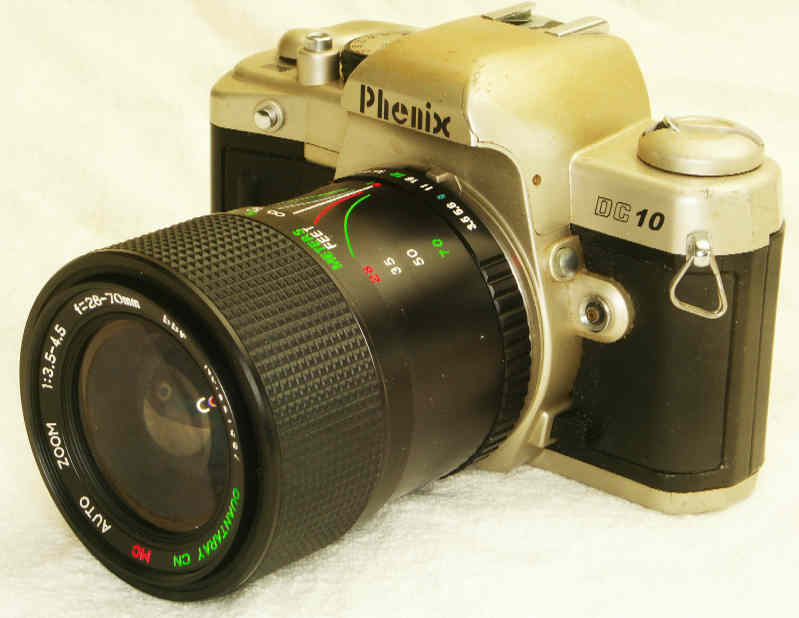
Then there is a Kalimar KX-5000 with a Spiratone Minitel 500mm f8.0, catadioptric, mirror telephoto. The mirror optics of this design make the 500mm lens compact and light.
Spiratone sold at least three versions of a 500mm f8.0 mirror lens. One was the Ultratel and the others were the better-known Minitel. These last two look very similar but were made by different companies. The first version, shown here, was actually made by Tomioka Optical for Contax/Yashica and it is a slightly stripped down version of their Yashica Reflex ML 500mm f8.0 lens, which in 1985 had a list price of $525 ($1,150 in today's dollars). It has close-focusing to 13 feet (unless you add on an extension tube), and a 77mm filter thread. Spiratone's later version had a 72mm thread (this is how you can tell the two apart) but it was not made by Tomioka Optical. The original Spiratone version was less expensive than the Yashica, but they never mentioned that it was really a Yashica lens. The difference is that it has a non-rotating tripod connection, it has a T-mount on the rear (instead of a Contax/Yashica mount), the Yashica built-in, sliding lens shade was removed, and the 35.5mm filters were screwed onto the rear instead of sliding into the light path on the side. It came with a case and four straps for 35.5mm filters (1A, ND 4X, and K2 yellow included) in the top of the case. The first version of the Spiratone Minitel had a list price of $299 and weights 1/4 of a pound less than the Yashica version. Nowadays, you get get one for about $50! The Yashica lens? Well, that still sells for about $500. Not much depreciation there!
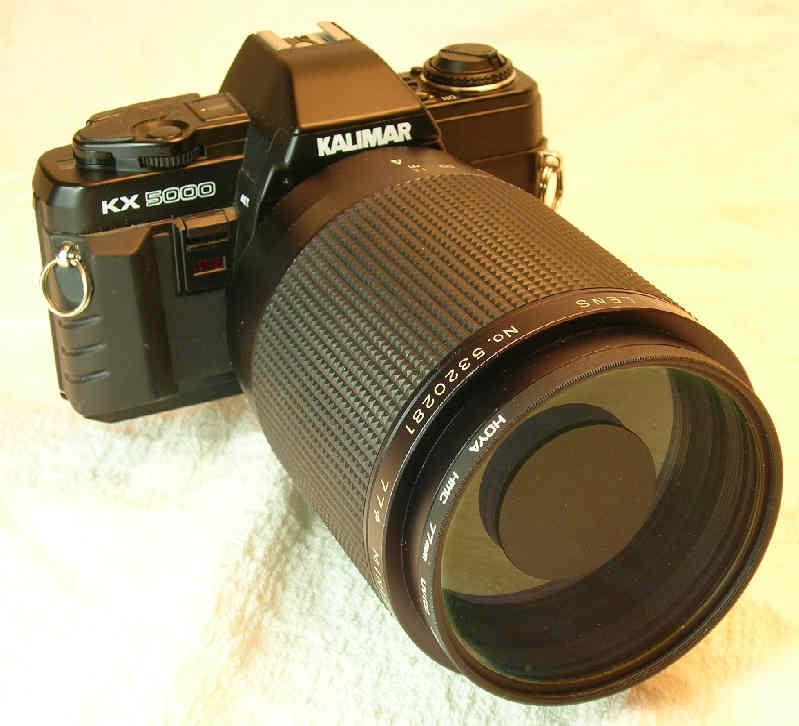
Someone recently spotted a Vivitar Series 1 24-48mm f3.5 zoom on a Braun SR2000 MD.
This lens is a two-touch zoom, so it can't have a depth of field scale, but it makes up for these shortcomings because it has a constant aperture as you zoom. It is a little on the larger size, and hefty, but it packs several lenses into one -- a 24mm, a 28mm, a 35mm, and a 50mm. Plus it is multi-coated -- as you can tell from the reflections in the photo. It was made by Kiron, a company that has made many wonderful lenses for themselves and others, such as Vivitar. You can tell if a Vivitar lens was made by Kiron because the first two digits of the serial number will be "22". The lens focuses to two feet, but with f-stops to f22.0, you can get just about everything in focus -- down to 1.75' at 48mm and 1.25' at 24mm. Need to get closer? Just slap on a close-up, supplementary lens/filter. It is a superb lens for scenery, interiors, and group shots.
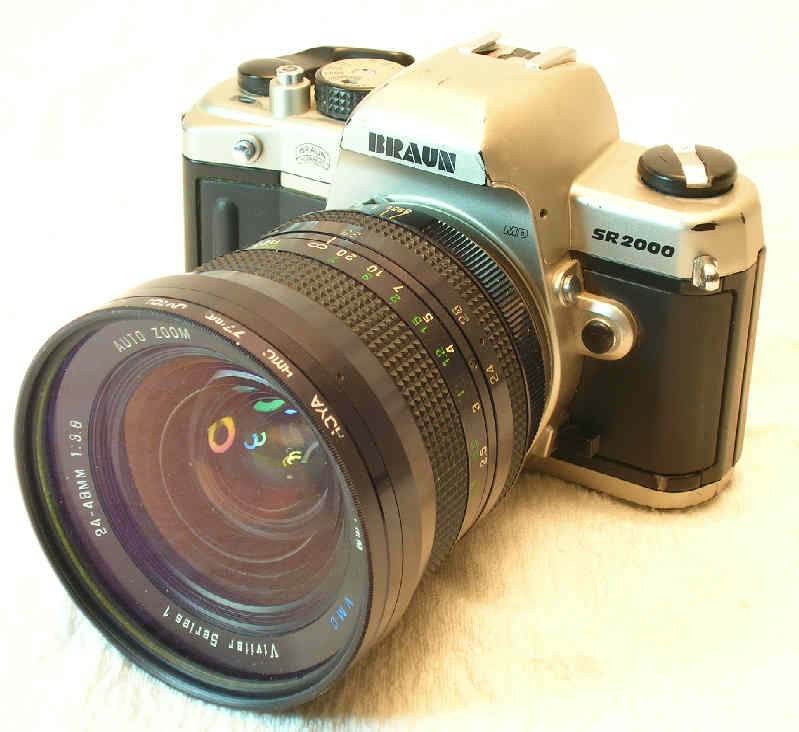
Take a look at this setup -- a Vivitar V50 on, appropriately enough, a Vivitar Series 1 800mm f11 Solid Cat!
The Vivitar 800mm f/11 Solid Cat is an almost one-piece glass construction lens. It actually has seven elements, which are VERY thick and VERY closely spaced into five groups along with two mirrors -- so, due to its reflective design, light effectively passes through 13 elements in 10 groups with two mirrors. Just like all of Vivitar's lenses, this one was not made by Vivitar. It was made by Perkin-Elmer a US company of NASA and US military space telescope fame. This lens has achieved cult status because it is very compact (only 3.3 inches long), sharp, and super-rugged -- partially due to its solid construction -- unlike most mirror lenses. The construction design means that the elements remain in the optimal fixed position relative to each other, despite professional use, non-professional abuse, or even temperature changes (a nasty culprit with very long lenses). Have you ever noticed that most long optics (reflective or refractive) will actually focus PAST the infinity marking? That's so you can correctly focus on infinity when the lens gets over-heated. This puppy is pretty heavy (3 pounds) and has a locking, rotating collar with a tripod socket. It close-focuses to 22 feet for a magnification of 1:8 -- not too shabby, as most lenses will only get you to 1:10. It uses easy-to-get 35.5mm filters on the rear and has an odd front filter thread. I measured it at 101-102mm but can't find any of those. Although I have filters for the rear, I wanted a front filter just to protect the front element. After some thought, the light bulb went on. Since it was made in the USA, it makes sense that it probably had a 4" diameter front filter, which happens to be 101.6mm! So I bought an Olympus 100mm (1A) Skylight filter and attached it with a tiny bit of silicone sealant and then modified it to accept my standard 77mm lenshood and filters -- when I don't happen to have the 35.5mm filter(s) that I want.
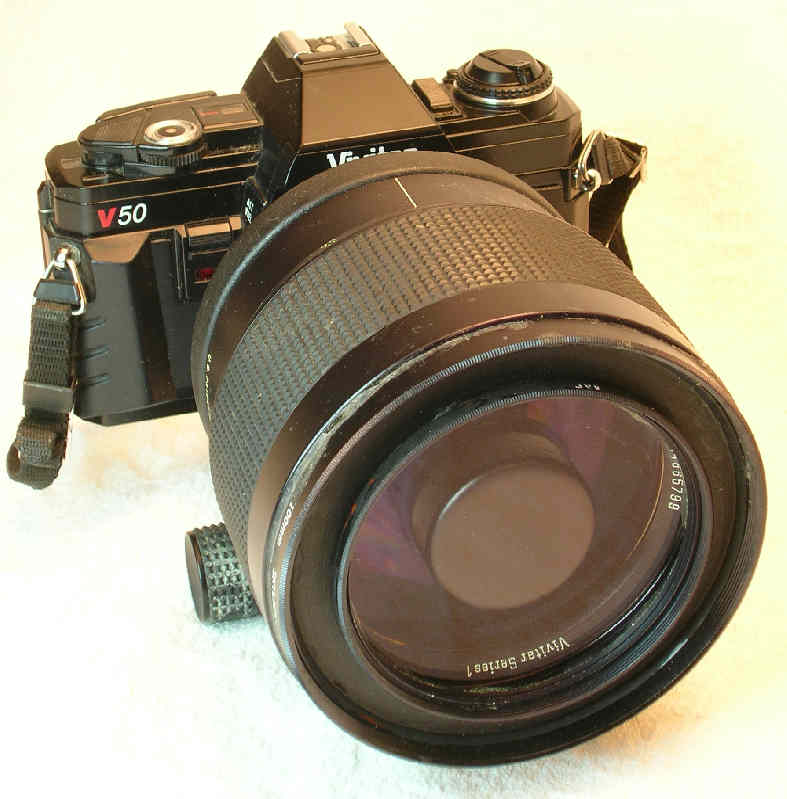
For some reason, somebody wanted to see a Minolta Rokkor-X 85mm f1.7 lens on a Seagull DF-300M. Well, here it is.
The Seagull is strictly a manual camera and with a very fast lens it is perfect for low-light photography where you need to meter accurately and carefully. Under many existing light situations, there is just not enough illumination for a TTL meter to accurately respond. Sometimes it won't register at all. But using a hand-held meter can easily rectify things. So, if you add on a fast 85mm lens to a Seagull DF-300M, you have a great set-up for candid and clandestine people shots.
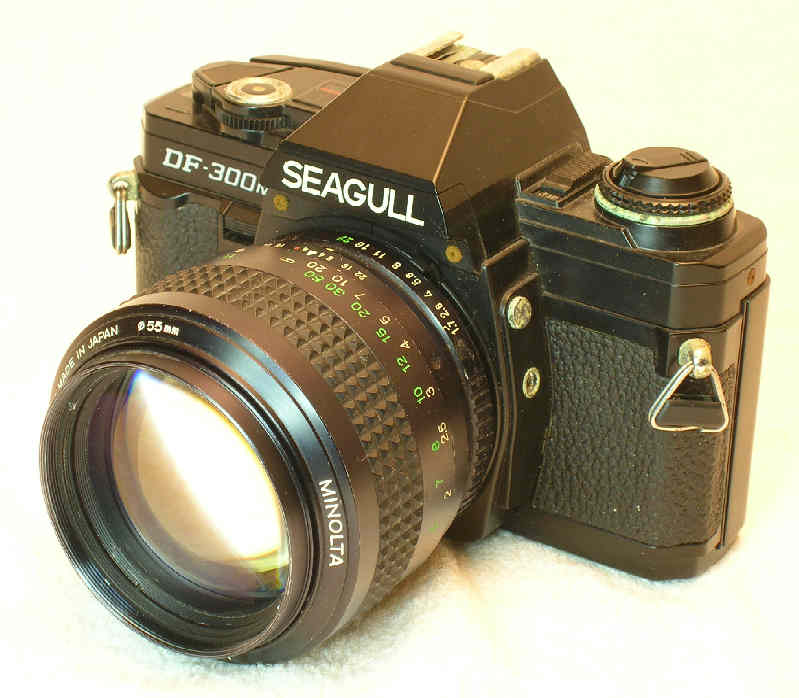
How about a Mingca S-201M paired with a Sigma APO 500mm f7.2 telephoto?
Any of the Sigma APO 500mm lenses are best used on a tripod and with Mingca's waist-level finder and magnifier it makes for a win-win, stable, and easy-to-use set-up. The Sigma APOs are SUPER-sharp. Their f7.2 version, seen here, close-focuses to 12 feet, but with an extension tube or a low power close-up lens, such as Minolta's CU lens for their Rokkor 100-500mm zoom (a +0.33 diopter), it is also great for close-ups. The Sigma APO 500mm f7.2 is not as fast as its big brother (f4.5) but it is a LOT cheaper, a LOT smaller and a LOT lighter, plus it has fast, internal focusing and a rotating collar with tripod mount. It's shorter than you might expect due to its telephoto design. It's still hard for me to believe, but one, in excellent condition, recently sold on EBAY for only $60! I guess it's because most people don't know about it. The Mingca uses the PMH-type lens mount (see above), so you need to be especially careful when using valuable lenses.
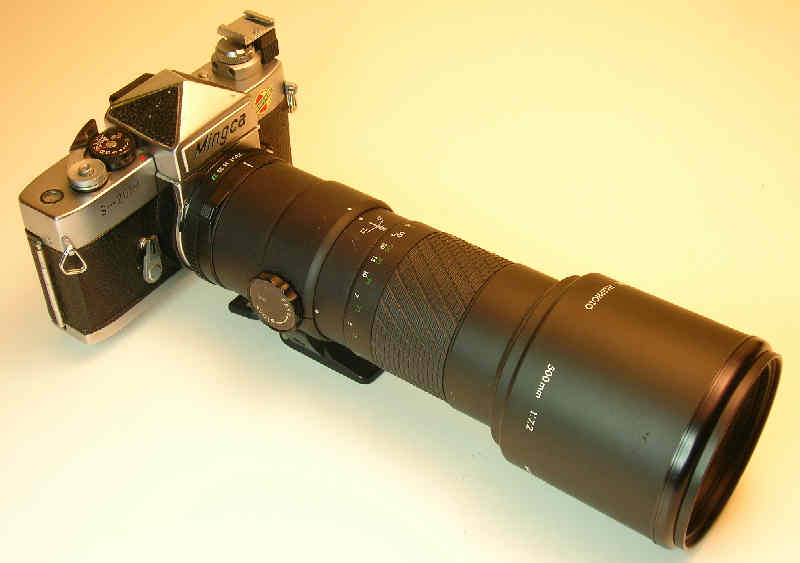
This J.C. Penny 28-80mm zoom fits the Seagull DF-99 perfectly
The lens has a wide zoom range, is a one-touch zoom, a f3.5/4.5 aperture, and has a MACRO mode. The DF-99 has three LED's in the viewfinder which indicate the correct exposure as you manually change the shutter speed (1-1/1,000, plus B) and the aperture. The viewfinder has a split-image rangefinder with a micro-prism collar, and shows a RED LED on the top for "over-exposure", a GREEN LED in the middle for "correct exposure", and a YELLOW LED on the bottom for "under-exposure" -- when the plain (non-sensa-switch) shutter release is pressed half-way.
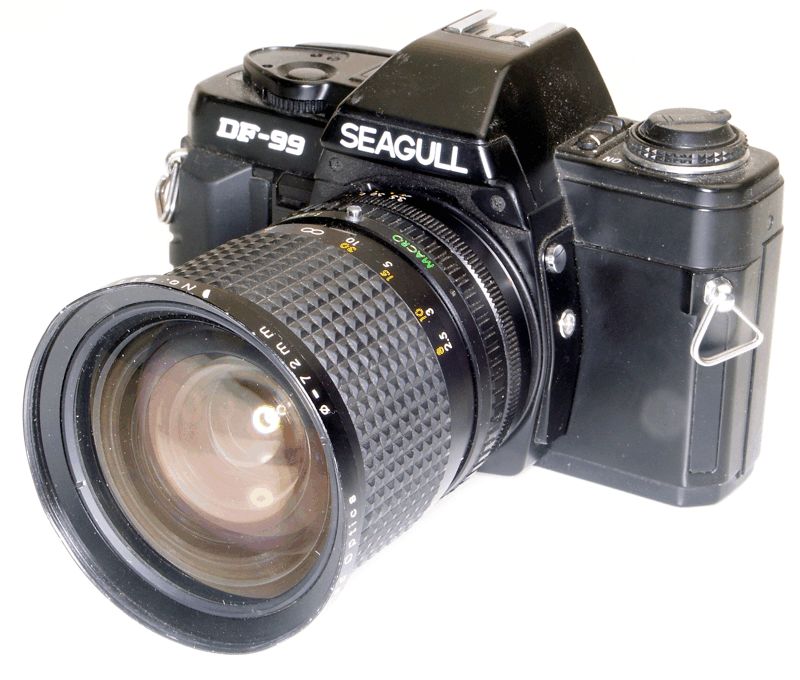
A passerby wanted me to slap a rather pedestrian optic onto something phenomenal -- so I did!
Here's a Mingca 50mm f2.0 lens on a Seagull DF5000 "Colani" with matching motor drive. The Mingca is a great little lens -- not a speed-demon, but it's compact and designed to look like a Pentax K-style lens. It has a PMH mount, so it fits on the Seagull DF5000 just fine. The Pearl River, Mingca, and Huaxi lenses all use the same mount which has a locking mechanism similar to Nikon, but they were smart enough to add the Minolta style lock to their lenses. So their lenses will work fine on any type of camera. Seagull did not add the same dual compatibility to their lenses, however. And, of course, the Seagull DF5000 is in a class by itself, not because of its Colani covering and motor drive, but because it has features than no other Chinese/Minolta-style camera has -- like TTL flash metering.
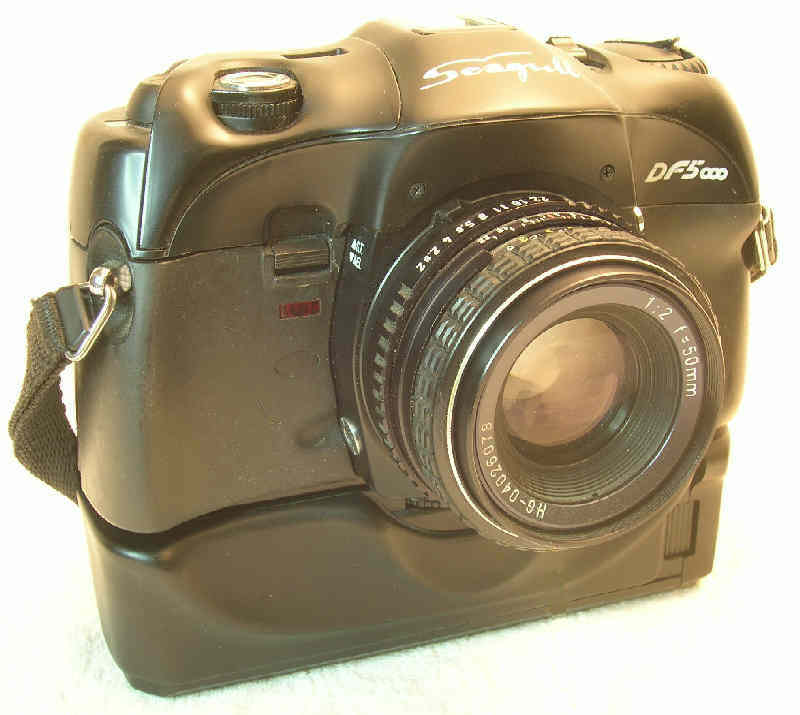
How about a Soligor 85-205mm macro zoom on a Sakar SL-90MD? Why not?
The Sakar SL-90MD is the same camera as the Seagull DF-2ETM and the Zenit DF-2ETM, except that it is normally seen with a Sakar 50mm f1.7 or f1.8 lens, of course. So why not broke ranks and teamed it up with the substantial Soligor (made by Sun Optical) C/D 85-205mm f3.8 macro zoom. It makes for a very effective photographic collaboration with TTL metered-manual exposure control.
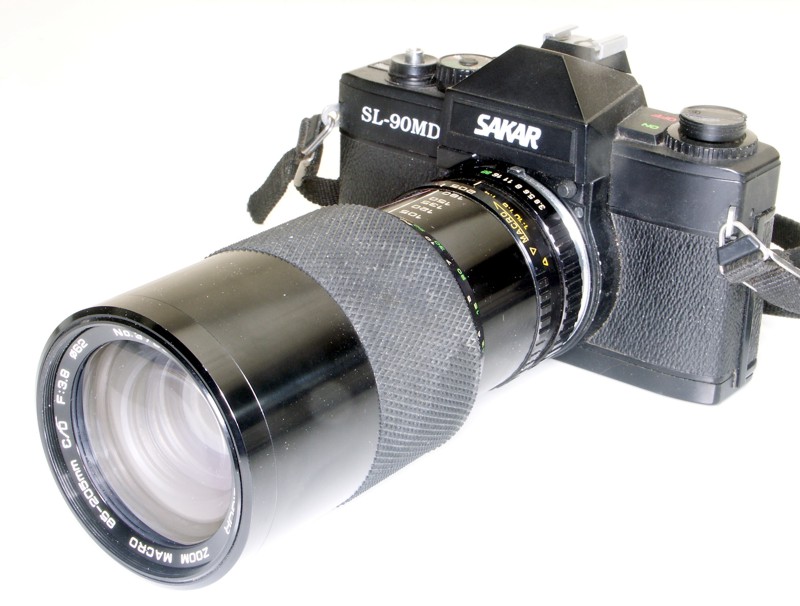
Doubters say that you can't put a 12mm rectilinear (non-fisheye) lens on a Chinese camera. You just can't! Well, I'm here to prove them wrong!
Here's a Voightlander Aspherical 12mm f5.6 Ultra-Wide Heliar lens on a Panda SLR. Nowadays, Voightlander lenses are made by Cosina and they make several outstanding (and expensive) lenses in a variety of lens mounts. They made the 12mm in Leica, Sony and Nikon mounts -- they now make a 10mm f5.6, if you can believe that -- but the mount is easy to remove and then other mounts can be attached instead. In this case, a Minolta Rokkor mount was installed. When switching mounts there are a few things to consider. First, the camera to which it will be attached has to have a mirror lock up because the lens is so deeply set. Fortunately, the Panda offers this. Then there is the spacing between the lens and the film. It needs to be pretty precise. With a typical 35mm SLR, you will need to remove the focusing ring of the lens to get the rear of the lens close enough to the film plane. This eliminates the ability to focus the lens, but that is not a big obstacle due to the inherently wide depth-of-field. Many super-wide angle lens do not need, and some do not have, focusing rings, such as the Minolta Rokkor 7.5mm fisheye lenses. You'll need to set the distance for the lens at the hyperfocal distance to make sure that infinity will always be in focus even if the lens is used wide open. Some cameras may not allow the correct distance to be set for the 12mm, even with the focusing ring removed, and even if it does, it needs to be measured carefully. Fortunately, with this lens you normally would want to stop down to at least f11 to minimize light fall-off, and then the extreme depth-of-field will get everything correct. So it's not too difficult to accomplish, but buying this lens is not cheap and you better be sure of your mechanical abilities before you "play around" with a lens that may not fit and cannot be returned. (I made a rear lens cap for the lens by gluing together a Minolta rear lens cap and a 35mm film canister.) This lens, like other lenses that require a mirror lock up (such as the Minolta W. Rokkor-QH 21mm f4.0), is supplied with a hot shoe mounted viewfinder so you can see -- very approximately -- what you will get.
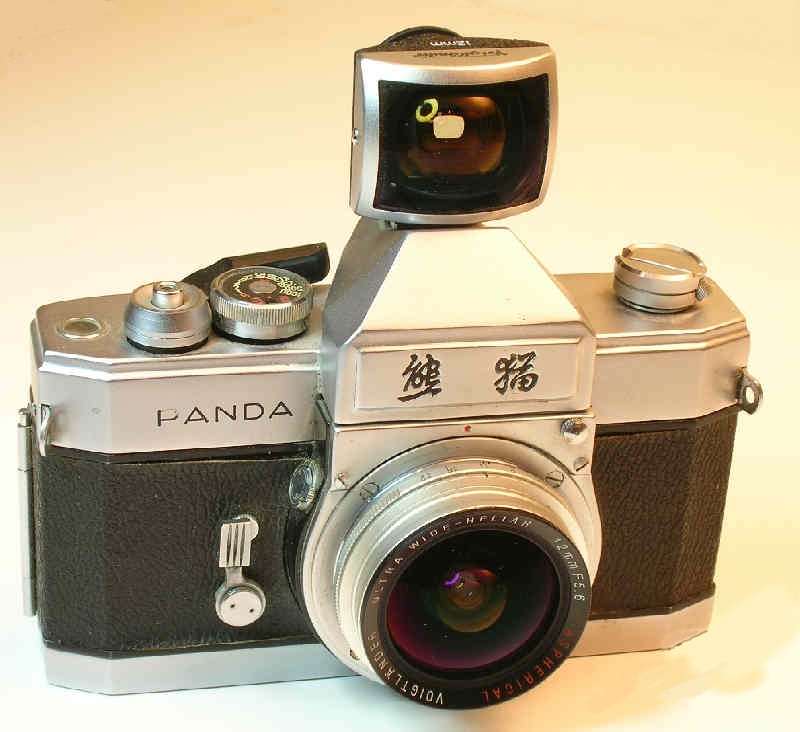
The curious case of the Sears 28mm macro on a Texer EX-3
The Texer EX-3 is hard to find, but the Sears 28mm f2.8 wide-angle macro is even more reclusive. They have never been seen together -- until now. The Sears 28mm is incredibly small and light and focuses down to 1:4 life-size. It works perfectly well with the TTL automatic metering, and manual features of the Texer EX-3.
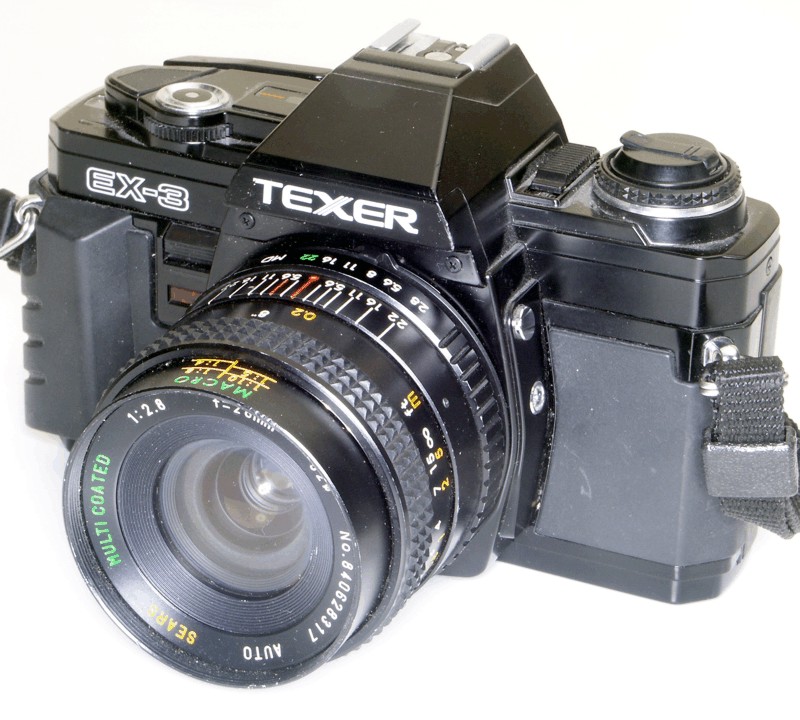
Now here's A-HUNK-A-HUNK-A burnin' glass -- a Sigma XQ 135mm f1.8 teamed up with a Seagull Reflex DF.
The Sigma is hard to find, but most people don't know about it so it can often be had for a lot less than you might expect. Believe it or not, it actually had some competition. There were a few other 135mm lenses faster than f2.0. Most were f1.8 models, such as Spiratone, and both Carl Meyer and Vivitar made f1.5 versions. There is even a Speedmaster f1.4 from Mitakon -- if you happen to have $3,000 burning a hole in your pocket, you can still get one new. The Sigma was available in two slightly different versions -- the Sigmatel and the Scalematic. This one, the Scalematic version, allows you to set the focus based on the size of the subject -- if you want. It has a YS mount, which was an alternative to the T-mount and Adaptall mount, of the same era, but from other lens manufacturers. The Sigma XQ line of lenses has some truly amazing specimens and even some cult favorites, like this 135mm f1.8 (becoming a 270mm f3.6 with a 2X converter) and the 500mm f4.0 mirror. The YS mount was used by many lens manufacturers -- not just Sigma -- for quite a while. Information about this type of mount can be found at: http://www.butkus.org/chinon/y-s_mount/ys.htm The Seagull Reflex DF is about as hard to find as this lens, but well-worth the effort.
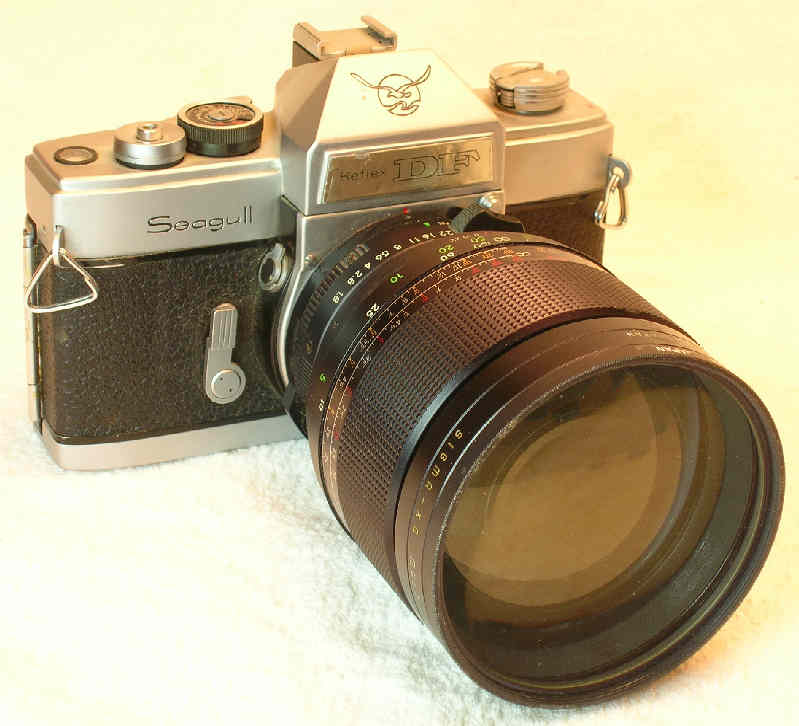
An Auto-focusing Peafowl DF.1? You've got to be kidding!
Actually it's easily done with the Vivitar 75-200mm f4.5 Auto Focus Zoom. It uses three internal AAA batteries to power the auto-focusing in single or continuous focusing mode. When the subject is in focus, the lens beeps and flashes a red light -- and it can always be used in manual focus mode too.
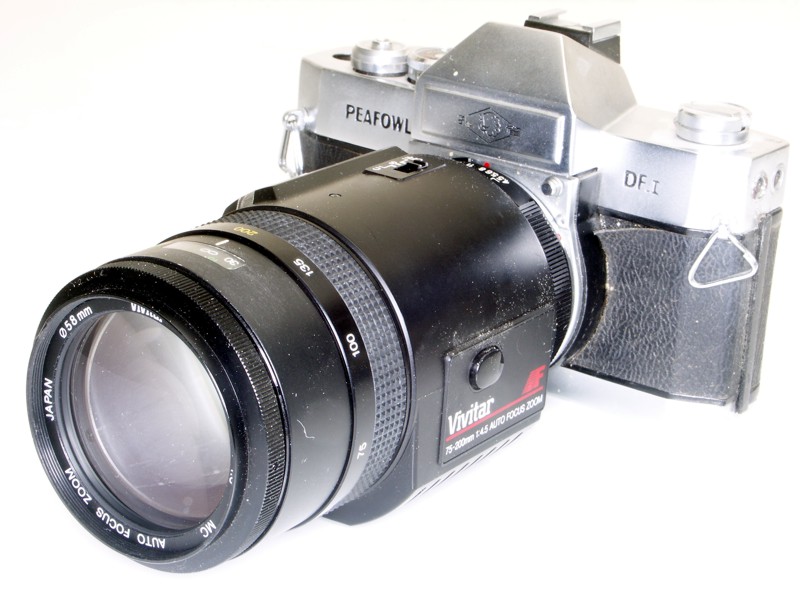
If you happen to be planning a safari anytime soon, I have the perfect photographic package -- a Safari DF-300 with a Tokina 28-85mm f4.0 zoom and a Minolta MD-1 motor drive.
The Safari offers you both manual and aperture-priority automatic exposure so you can easily "capture" the rhino as he charges without having to think. The Tokina zoom lens allows you to deal with anything from group shots of the expedition's porters to more distant happening in the jungle -- its constant f-stop feature means no exposure problems even with a flash. And the Motor Drive -- up to 3.5 frames per second -- means you better bring a lot of film.
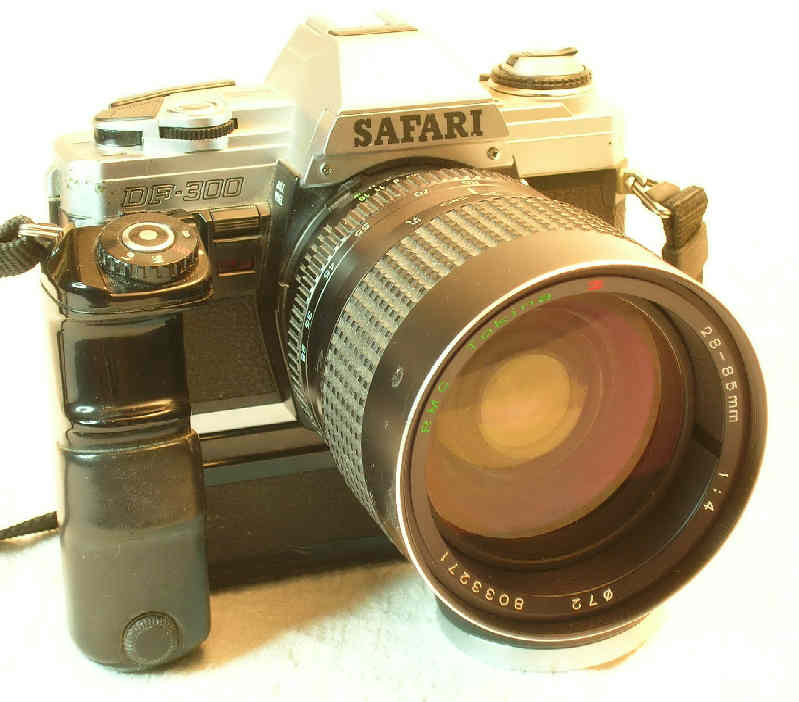
What the heck, let's get REALLY crazy and put a microscope lens on a Phenix DC700.
The Phenix is probably the easiest part of this combination to find. But it's up to the task with its TTL metering and compensates automatically for the light loss due to the bellows extension -- in this case the amazingly tiny, collapsing Minolta Compact Bellows. When using a short focal length lens, in this case, the Minolta 25mm f2.5 Bellows Micro lens and an M-2 extender / adapter (Minolta's 25mm and 12.5mm Bellows Micro lenses have a RMS (Royal Microscope Society) thread of 0.8"), magnifications of 20-40X are easy to obtain.
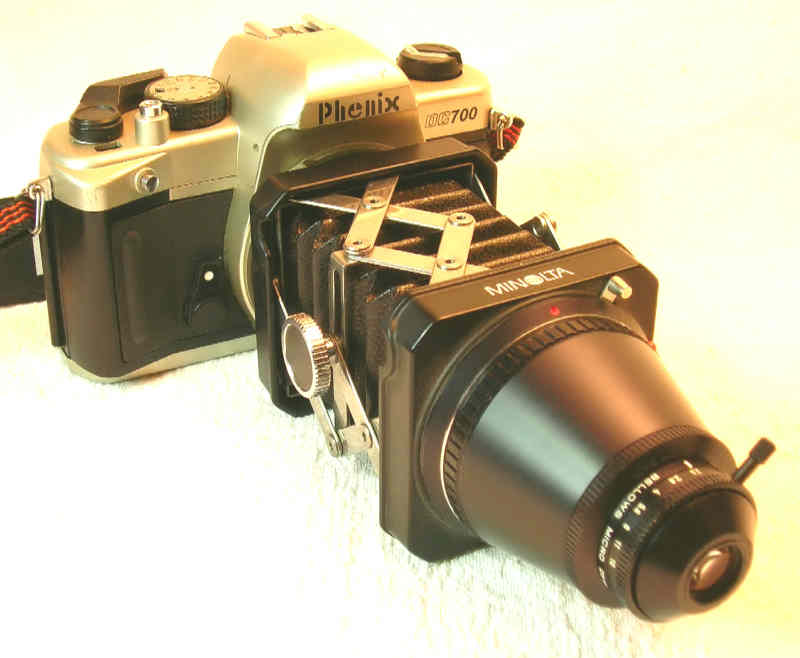
Let's not forget to put a Minolta Rokkor-X 7.5mm on a Seagull DF-300H, for Pete's sake!
The Seagull DF-300 is different from the other Seagulls in its SHINY black covering, an EXTRA-large hand-grip, PLUS the fact that it is an ALL manual shutter speed camera. It has a TTL meter and an electronic shutter, but the shutter speed (1/1,000 - 2 seconds) and f-stop are set manually. That's OK with the Minolta 7.5mm -- which is a circular fish-eye lens. It does not fill the 24 x 36mm frame, and produces a circle image, instead of a rectangle. The depth of field is so extreme that it lacks a focusing ring and it fixed at the hyperfocal distance. What looks like a focusing ring is a FILTER ring which is rotated to change the numerous, built-in filters.
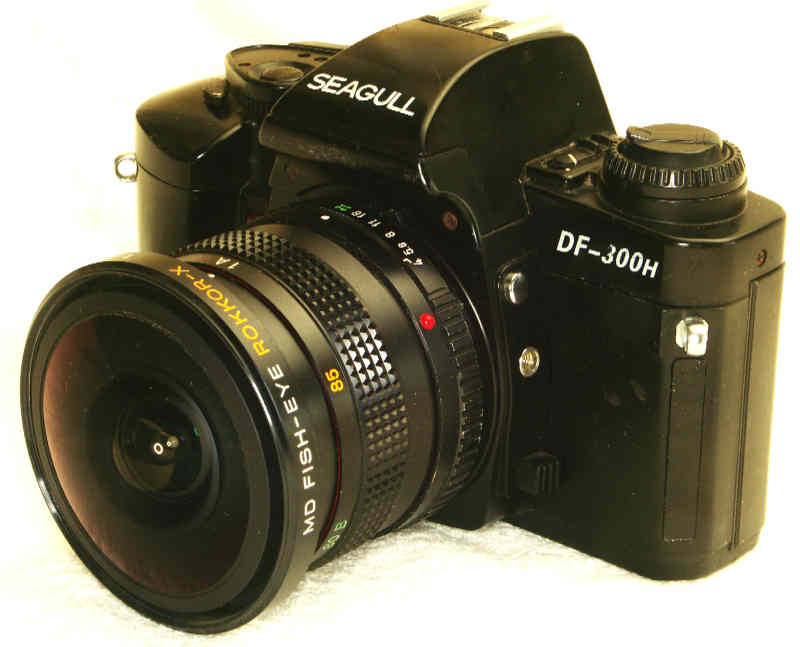
Let's team up a Phenix DC505 with a super-fast Soligor C/D 200mm f2.8.
The "C/D" in the Soligor name stands for "Computer Designed". There were many C/D lenses from Soligor -- made by different manufacturers, such as Tokina. Their Tokina-made 650mm f8.5 mirror lens is a gem. These lenses are all multi-coated and known for their WIDE apertures and top-notch results.
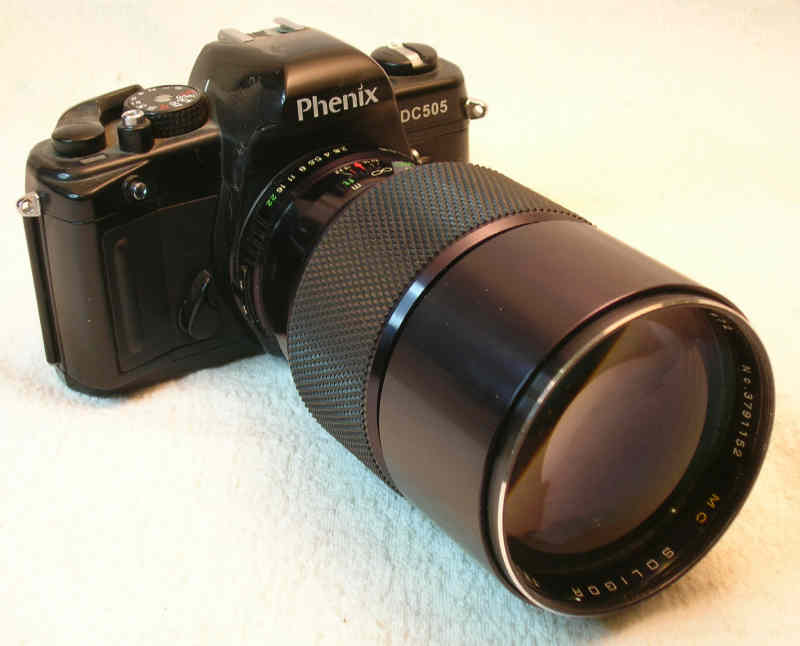
Then there is the mysterious case of a Vivitar 21mm f3.8 on a Phenix DC701.
The Vivitar 21mm might be a little hard to find but it is very well made, and inexpensive for a lens this wide. It has a depth-of-field scale and focuses REALLY close. The 77mm filter thread negates any vignetting, and the TX mount allows it to fit on just about any SLR.
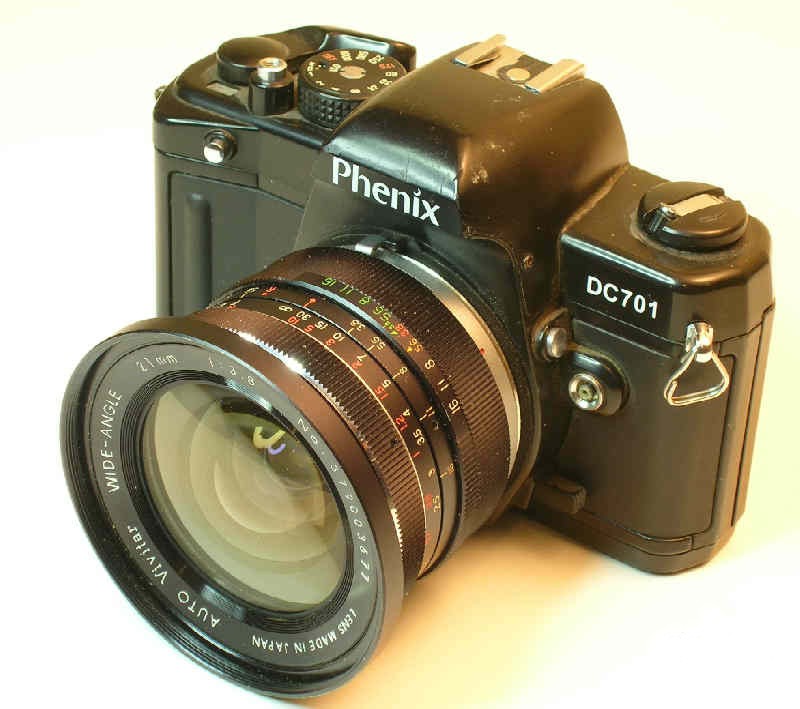
How about a colorful Texer 28-70mm macro zoom on -- what else -- a Texer EX-3.
The EX-3 is a re-badged Seagull DF-300, and the lens is a re-badged Seagull zoom, but this combo is eye-catching -- and catches great results!
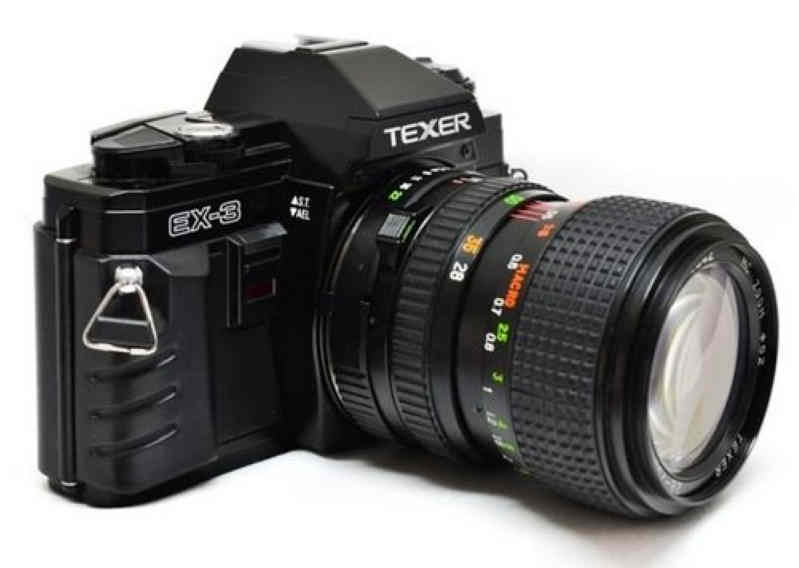
Just try and find one -- the elusive Seagull DF-777..
There weren't many made but it must have been Seagull's least expensive camera. It is surprisingly lax in features. It doesn't even have a cable release connection. No meter, but the shutter does need a battery -- and it does have a self-timer. They probably kept that feature so they could drop the cable release connection. Still, when teamed up with a true, all-in-one Vivitar 28-210mm macro zoom, it can compete with the "big boys".
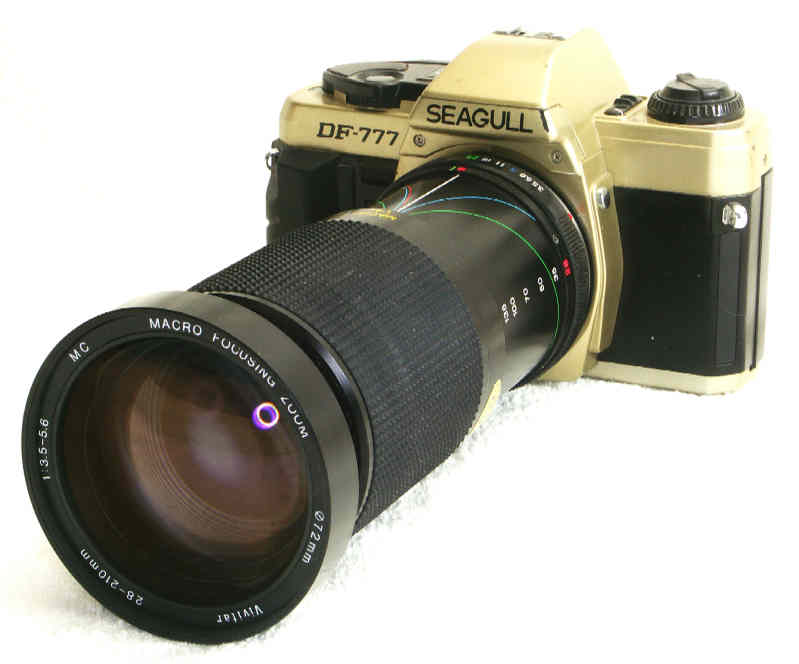
Well what do you know? We found a Phenix DC10 with a Osawa 650mm f8.5 mirror.
The DC10 sounds diminutive but it is loaded with features. Add on a Tokina-made Osawa 650 f8.5 lens and you're ready for surveillance work! This lens was also sold under the Soligor and Bell & Howell names, but never under the Tokina label.
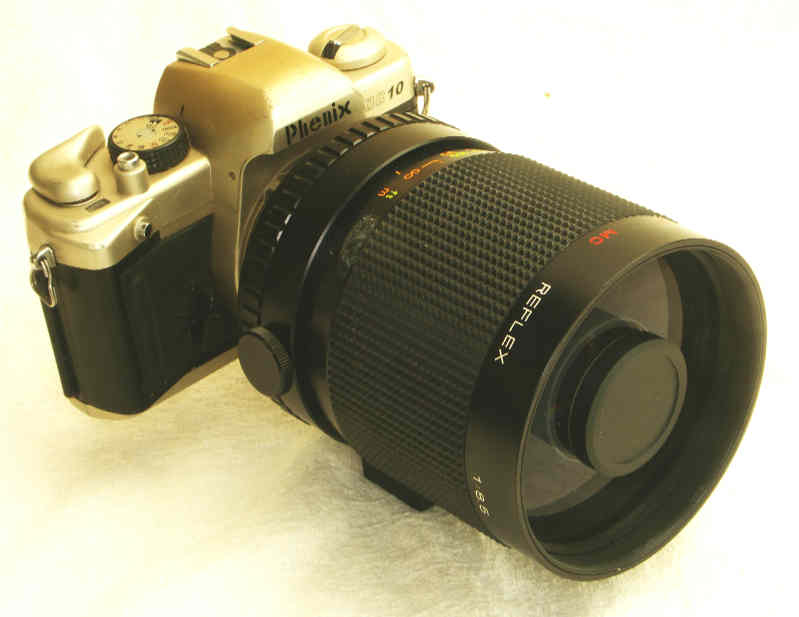
The Seagull DF-1000 works well with a Tokina SD 70-210.
The DF-1000 is not loaded with features, but add on a super-compact Tokina SD 70-210mm f4-5.6, and your ready for some great shots.
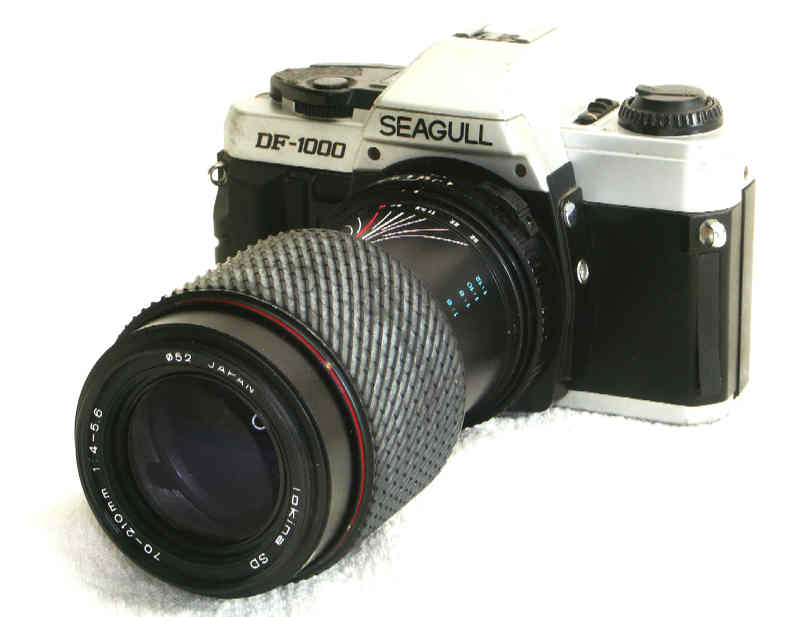
Here's a Seagull DF-500 and a Minolta Rokkor-QF 50mm f3.5 Macro.
The DF-500 has plenty of features, like metered-manual and automatic exposure modes, but it lacks a depth-of-field button. That's no problem with this Minolta lens -- shown here fully-extended with the 1:1 extension tube -- because this version of the lens has a DOF lever built-in.
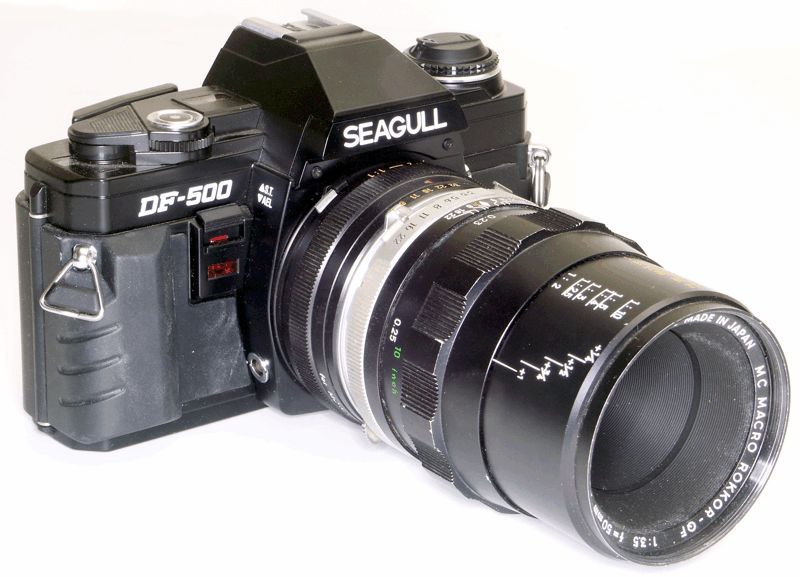
The unique Vivitar 28-85mm needs a unique camera like the Vanta G-5.
Kiron made the amazing 28-85mm f2.8/3.8 parafocal zoom for Vivitar. While not a small or light zoom, it covers everything from wide-angle to tele in a one-touch configuration with superb results. And the Vanta G-5 fits it well with unique features, such as a DOF button, easy multi-exposure capability, and even a "T" shutter setting. .
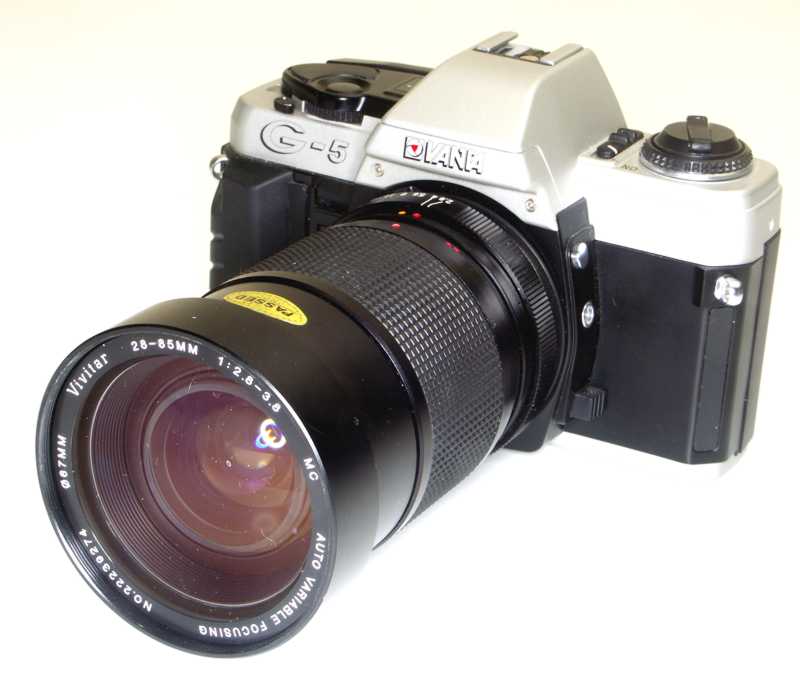
The tiny Quantaray 300mm CAT works quite well with a Seagull V-300D.
The V-300D is not the only Seagull SLR without the "DF" designation, but it has everything necessary for fast-action photography, such as auto-exposure and motor-drive capability. That's where a compact telephoto comes in. The Quantaray 300mm f5.6 was marketed under several labels, and was probably manufactured by TOYO Optics. And the V-300D can stamp all of your shots with the date!
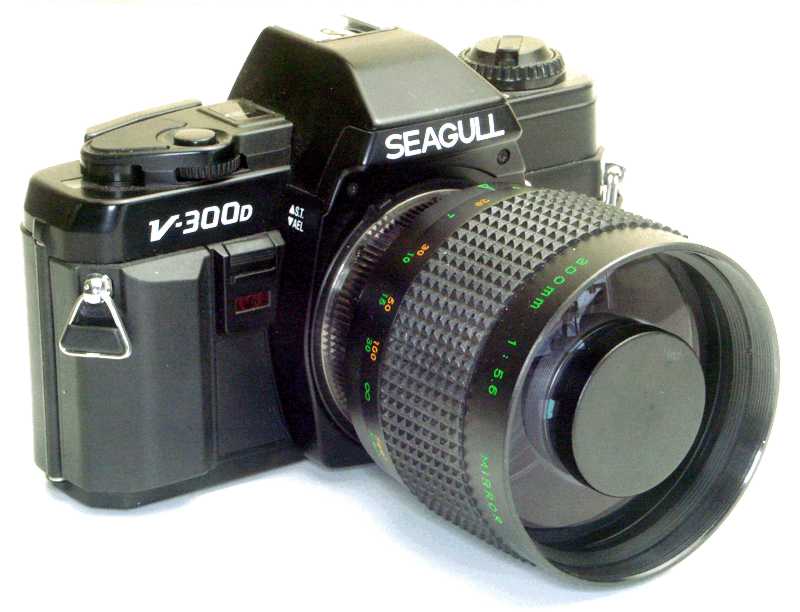
Putting an Exakta 35-200mm on a Carena SX-300 can't be beat.
The Carena SX-300 has plenty of features to work with, and pairing it with an Exakta 35-200mm f4/5.6 is a winning combination. Exakta lenses are frequently seen on Carena cameras, and the 35-200mm has you covered from wide-angle to long shots -- plus a macro made.
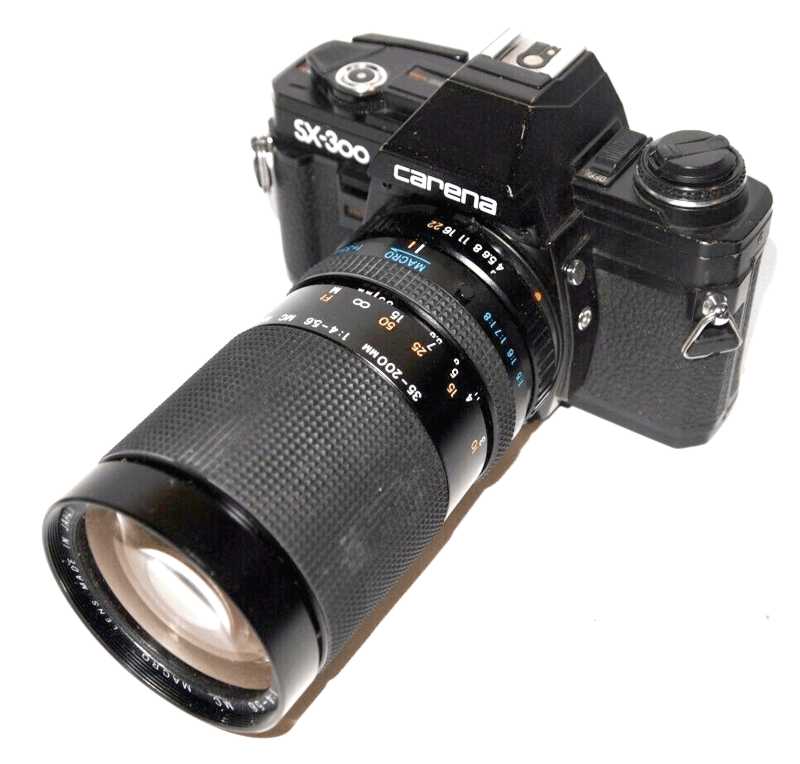
On the other hand a Seagull DF-102b only needs a Minolta 45mm lens.
Some would say both the camera and the lens are "pedestrian". Sure, neither is loaded with a lot of features or extras, but sometimes simple and easy is all you need. It allows you to focus on the subject.
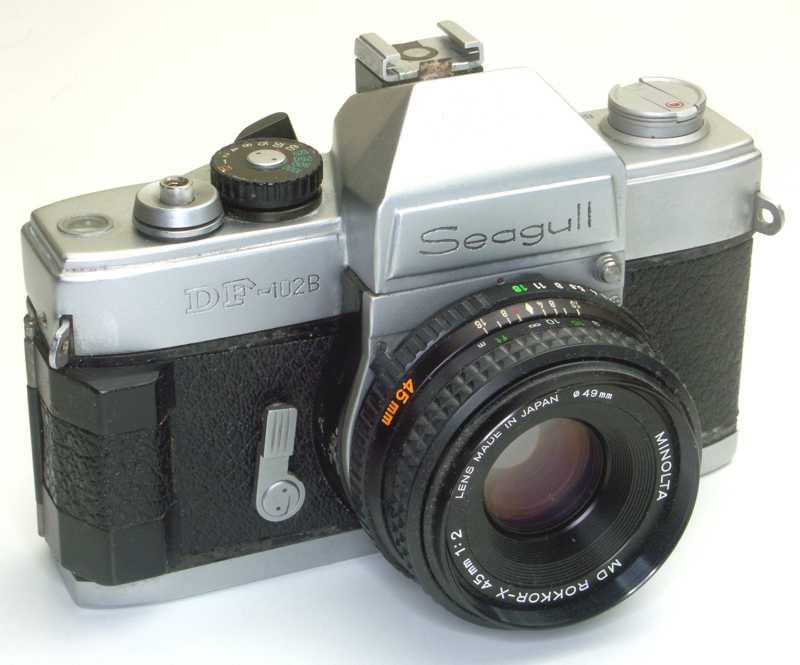
Let's combine a hard-to-find Sakar SL-90MD with a hard-to-find Sakar 80-205mm zoom.
Despite having a mechanical shutter, the Sakar has a TTL meter and viewfinder LED readout for correct exposure by adjusting the shutter speed or the aperture. Combining it with the Sakar Macro 80-205mm f4.5 zoom makes for a hard-to-find team. The compact lens has a built-in, sliding lens shade, a constant aperture as it zooms, and close-focusing at any foacal length to 30 INCHES!!!
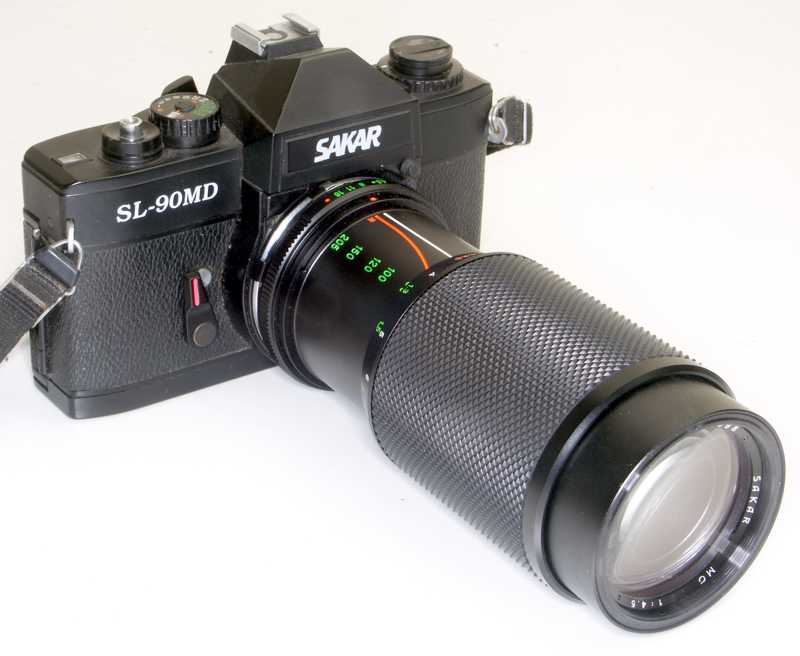
If you demand auto-focusing in a Seagull camera, Sigma has the answer.
Here's a loaded Seafull DF-200A with a loaded Sigma AUTO-FOCUSING 55-200mm f4.5 zoom. The DF-200A has shutter speeds to 1/2,000s and easy multiple exposure capability. The Sigma 55-200mm covers normal to telephoto shots, and has a constant aperture while zooming. Zooming is accomplished by turning a collar around the lens, and auto-focusing is done by presssing a button on the side of the lens that naturally falls under your thumb. It is powered by three AAA batteries, and manual focusing is just as easy.
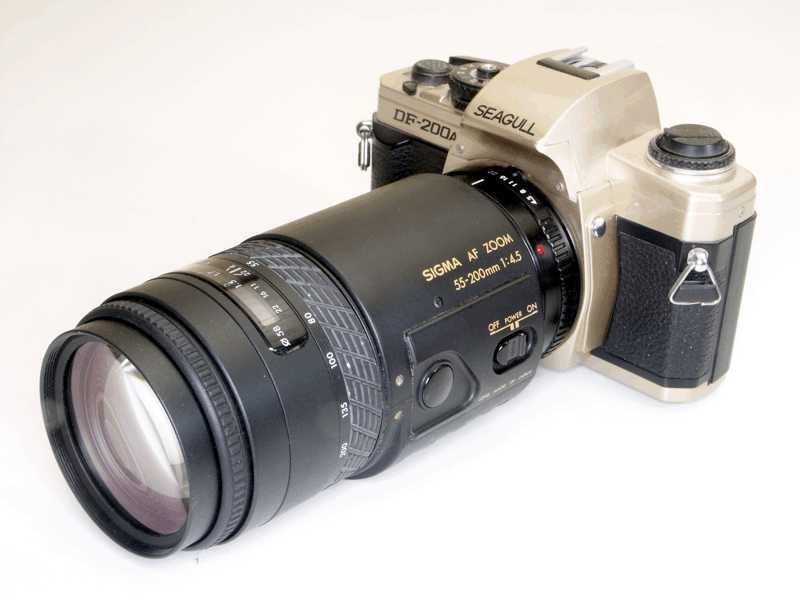
Celebrate the new millennium with a Seafull DF-1000 MC and a great Seagull 28-70mm f3.5/4.5 zoom. The DF-1000 MC offers straight-forward meterless simplicity with an electronic shutter offering speeds from 1/1,000 down to whatever you want. The Seagull 28-70mm covers just about every subject you can imagine.
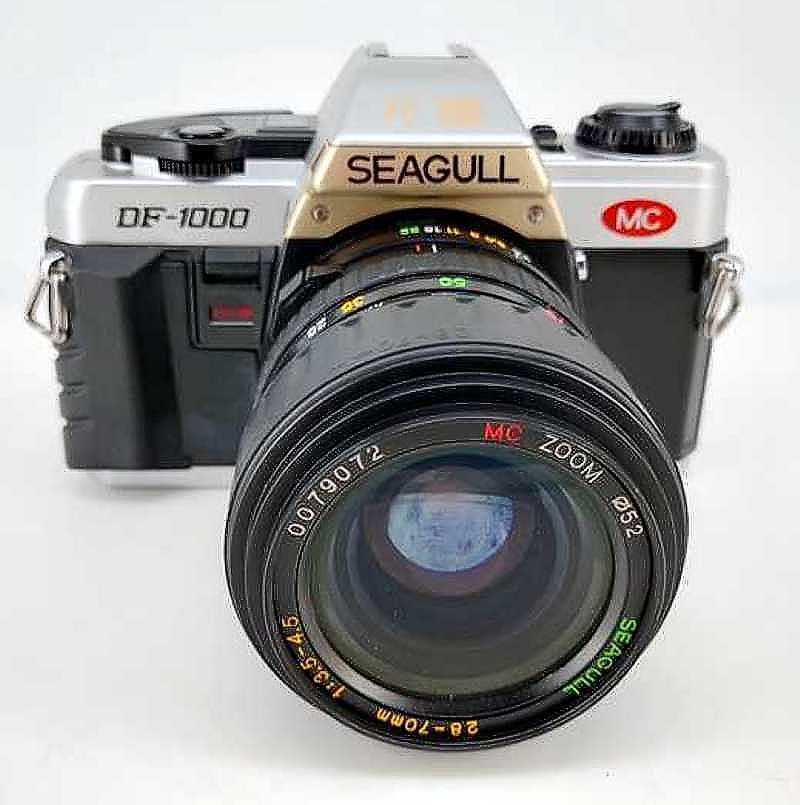
A step up from the DF-100. The DF-200 model adds a meter. The meter is pretty basic but works well. It has three LED's for OVER, UNDER and OK in the viewfinder. It is strictly a manual meter and no automatic exposure is available. It has the same vertical-travel shutter which is completely manual, and does not need a battery. So if the meter dies, or the battery is dead, or the meter is not turned on, the camera can still take a picture -- from 1 second to 1/2,000. And in a hard-to-find Seagull 135mm f2.8 lens and you're ready for great portrait shots.
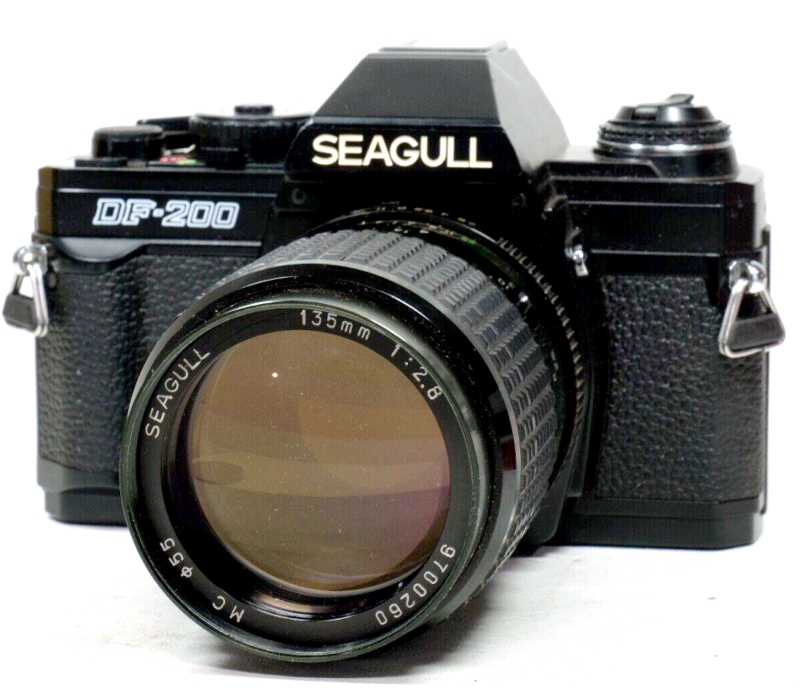
And speaking of the DF-100, here it is with a basic 50mm f2.0 lens. It's the DF-200 model without meter. As long as you remember the f-16 rule, you are all set
